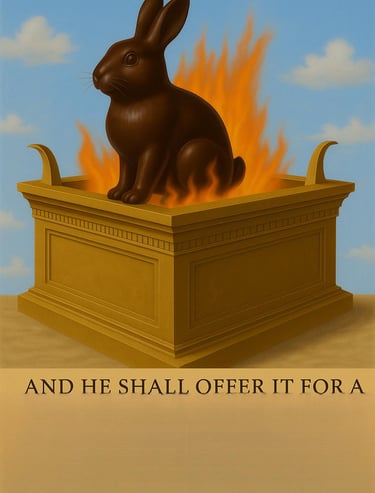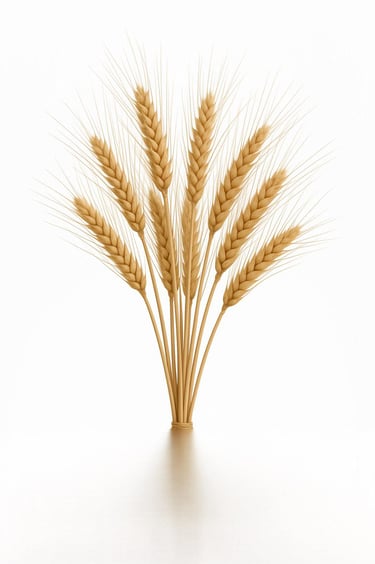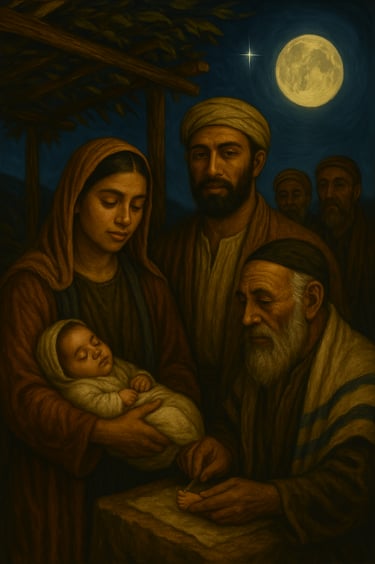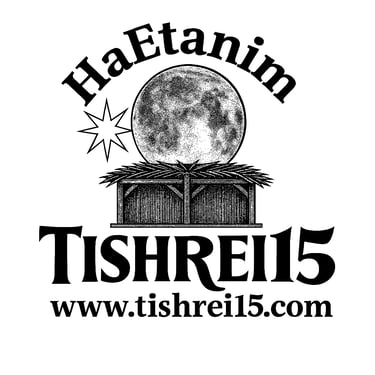Announcing that the great day of the lord is nearer than you think. O Come let us adore him - Luke 2:13

Moed the Appointed Times
The Messiah is intimately connected with all His Appointments.
These are the Times of the LORD God.
Shabbat שַׁבָּת
Ring F
It was, indeed, in the town of Nazareth—His, he being Yeshua, place of upbringing and early habitation—that He returned; and, in accordance with a practice long established and never abandoned, He entered the synagogue upon the Sabbath. That day, hallowed from the first, He took His place and stood to read, as was the custom of one well-acquainted not only with the letter of the law but with its spirit. The Sabbath—oh, that most beneficent appointment!—was not instituted as a mere burden of ritual, nor devised as a constraint upon liberty, but rather fashioned for the benefit of man, tenderly placed after his creation. It is, and ever has been, the seventh day: a conclusion to the week’s labours, a quiet sanctuary wherein heaven and earth reflect in mutual repose. Indeed, it marks also the appointed turning of the Mishmarot—the courses of priestly service—a rhythm set by divine ordinance, and adhered to by those who seek both reverence and order. Thus, in the solemnity of that day, we perceive not only cessation, but transformation, a holy choreography written into the very fabric of time.
Pesach פֶּסַח
Ring H
Passover
It is a matter of solemn record, and one not to be taken lightly, that the offering of the single Pesach Lamb was ever to be conducted before twilight on the fourteenth day of the month of Nisan, or Aviv, as it is called in the more ancient tongue. This moment—so full of reverent anticipation and sacred intent—was the hour appointed for that Lamb to be brought near, that it might be offered according to divine ordinance.
In this sacred appointment, we find a foreshadowing most profound: for it was likewise at this very time that Messiah Yeshua, the Lamb without blemish, was offered up. His sacrifice, unlike any before, was not a matter of convenience nor of happenstance, but determined with perfect forethought. The marvel of that single Lamb, whose body was consumed according to the sacred ordinance, was not the end of the matter, but rather its wondrous prelude. For upon the seventeenth day of Nisan, there occurred a mystery far greater still—the same Lamb, now risen, ascended to the Father as the offering of First Fruits on behalf of us all. Thus was the ordinance not merely fulfilled but gloriously accomplished, and the heavens themselves bore witness to the consummation of divine intent. The day of His offering was indeed the fourteenth of Nisan, chosen not only for its correspondence with the commandment, but for its alignment with yet another sign most wondrous.
As the sacred offerings were lifted up upon their הָעַמּוּדִים haʿammudim—those steadfast pillars prepared for the service of the altar—so too was Yeshua, the spotless Lamb, raised upon the wooden stake. Thus did the earthly shadow prefigure the heavenly reality, and what was once performed with beasts in the courts of stone was now fulfilled in Him upon whom all the offerings did rest.
For if one were to reckon three days and three nights from the time of His burial, one would find oneself upon the first day of the week—marked in that most notable year by the Festival of First Fruits. Thus do these sacred times coincide, each supporting the other with a harmony so exact it may only be ascribed to the wisdom of Providence.
And so, in this confluence of days—the fourteenth of Nisan, the reckoning of three days and nights, and the arrival of the day of First Fruits—we behold a tapestry woven with divine purpose. These are no ordinary coincidences, but rather the testimony of the appointed time, speaking in quiet eloquence of the fulfilment wrought by the One who came to do the will of the Father.
It is a point of no small curiosity—and one which invites both reverence and inquiry—that but two years in that era so precisely corresponded with the sacred events upon their appointed days. These were the Hebrew years three thousand seven hundred and eighty-seven, and three thousand seven hundred and ninety. By the reckoning of the Julian calendar, they are known to us as the years seven hundred and eighty, and seven hundred and eighty-three, respectively. Yet, of the two, it is the latter—year 3790—that presents itself as the most probable candidate for the fulfilment of these sacred occurrences.
Though it must be acknowledged as an anachronism, the corresponding year in the later Gregorian style would be the thirtieth of the Anno Domini. And thus, by careful measure and honest reflection, we perceive the remarkable convergence of heavenly design and earthly chronology.
It ought to be clearly stated—and with no reproach to any sincere soul—that this most sacred date did not coincide with what is now termed Good Friday, nor was the day of Easter yet conceived. Indeed, it would be quite unjust to assign fault to the Church in this matter, for at the time of these divine events, the Church as an institution had not yet come into being, and thus had neither voice nor opportunity to alter the appointed times.
The sacred chronology, as ordained from above and observed by the faithful remnant, remained untainted by later reckonings. The misalignment, if such it may be called, is the result of later centuries, not of those earliest and most hallowed days.
“On the Peculiar Case of Easter: A Reflection Most Necessary for the Properly Discerning Mind”
By an Observer of Customs, Sacred and Otherwise
It is a truth perhaps not universally acknowledged, but certainly in want of serious consideration, that a holiday so universally observed as Easter ought to be better understood by those who observe it. Amidst the great flurry of bonnets and blossoms, of eggs boiled and bunnies bound in foil, there lies a singular question which demands the attention of every reasonable creature: What, indeed, is “it”?
The Scriptures, in their venerable dignity, speak with clarity to those willing to hear. One must turn, as any proper inquirer would, to the twelfth chapter of Exodus, where the Almighty Himself commands that “it”—that is, the Passover—shall be kept by all the sons of Israel, save only those foreigners excluded for their want of covenant. This “it” is no trifle. It is not a matter of painted confections or rabbity novelties. No, “it” is a lamb: a male of the first year, without blemish, to be taken from the flock and consumed with haste and gravity.
Yet what, then, shall we make of these modern “easters” that are scattered like so many petals upon a spring gale? Are they flocking or herding creatures? That is, do they gather in solemn order or run amok like children in search of sugared prizes?
First among the possible interpretations lies the רְאֵם, known to the King James translators (with an enthusiasm not universally praised) as the unicorn. That rare and mythic beast—so majestic, so solitary—appears in Numbers and Job with great fanfare. The Greek stylists gave it one horn (μονόκερως), and the Latinists followed suit (rinocerotis), and thus the matter was settled for a time. But what household of Israel ever tethered a unicorn for slaughter, let alone roasted one for supper? And how, pray tell, might one determine its age, or whether it be blemishless? No doubt, a most uncooperative candidate for holy observance.
Next, let us consider the egg—בֵּיצָה—that unassuming oval now elevated to heights of ritual by means of dye, glitter, and hidden baskets. Is an egg male? Female? And must it be sacrificed over-easy, or poached, roasted, or scrambled with chives? And can one, in good conscience, claim unblemished status for something that is presently blue with pink polka dots? How can one not see the 'chagigah' as the antecedent of what PAAS has to offer. Aged eggs, too, raise concern, for a year-old egg would make any drawing-room most disagreeable.
The third suggestion—and I tremble to pen it—is the bunny, that אַרְנָבוֹן, so beloved by nursery and chocolatier alike. Rabbits are notoriously difficult to sex, a matter that may be of no consequence to the casual reveler but of great import to the Levitical priesthood. Roasting such a creature, especially in its dark cacao form, would no doubt result in ruin—of both the sacrifice and the cookware. And while the scent may indeed be sweet aroma, I doubt it would be accepted upon the altar as an קָרְבַּן עוֹלָה - 'olah', burnt offering. Though in and of itself it calls into question as to who invented fondue.
Then, of course, there is the ham, which must be most delicately handled. Not the son of Noah, of course, but the swine—בָּשָׂר חֲזִיר—whose very name causes the Torah scholar to recoil. That such flesh should appear at a feast meant to commemorate Israel’s deliverance from Egypt is an irony of the highest order. One may as well serve meatballs at a vegetarian’s wedding. Surely, those who partake do not mean to imitate Antiochus Epiphanes, though their table would suggest otherwise.
All this leads us, at last, to the lamb—שֶּׂה in Hebrew referring to 'one from the flock', ἀμνὸς in Greek—the one offering clearly prescribed, whose every characteristic is detailed with care. That John the Baptizer should look upon Yeshua and say, “Behold the Lamb of God,” is no chance metaphor, but a direct inheritance from the sacred texts. He, Yochanan, was declaring that Yeshua is the 'one from the flock'! It is Passover’s very heart, and the truest answer to the question: What is “it”?
Thus, my dear reader, as you gather your own “easters,” whether flocking or herding, boiled or molded, let not the solemnity of the commandment be obscured by confections or costumes. For the Lord did not command unicorn, nor egg, nor chocolate hare, nor deviled ham—but the lamb, and that unblemished.
In all such matters, let us think well, judge wisely, and eat reverently.





Unleavened Bread חַג הַמַּצּוֹת
Ring H


It is with no small degree of importance that I acquaint you with the commencement of a most solemn and distinguished appointment, which begins upon the fifteenth day of Nisan. This sacred interval, extending over the course of seven days, is oftentimes—though erroneously—referred to by the name of Passover, a misnomer which, though common, ought to be corrected by those who value precision in matters of tradition and observance. Within the bounds of this appointed season lies the celebration of First Fruits, a moment of profound significance, wherein the earliest yield is presented in reverent gratitude. It is also at this juncture that the counting of the Omer is initiated—a practice both meticulous and meaningful, marking the days with quiet anticipation and spiritual reflection.
Counting the Omer סְפִירַת הָעוֹמֶר
Ring H


It is a truth most reverently acknowledged, that the counting of the Omer serves as a delicate thread, binding the solemn observance of Unleavened Bread to the joyful celebration of Shavuot, otherwise known as the Feast of Weeks. This sacred progression, marked with quiet devotion and daily remembrance, is not merely a reckoning of time, but a journey of the soul from deliverance to revelation. An Omer, though modest in its measure, consists of a small bundle of barley—humble in appearance, yet rich in meaning. It is this simple sheaf, gathered with care, that becomes the emblem of the count, observed for forty-nine days with steadfast attention. Each day is numbered with intention, as if to say that holiness is not found in haste, but in the patient unfolding of purpose. And when the count is complete, the fiftieth day arrives not as a mere conclusion, but as a consecrated week—set apart in both spirit and celebration. It is a time of fulfillment, wherein the seeds of barley give way to the fruit of understanding, and the heart, having journeyed through days of reflection, is prepared to receive with joy.
Feast of the First Fruits - Barley Harvest חַג הַבִּכּוּרִים
Ring H
Yeshua was, by divine declaration, appointed as our offering of First Fruits. This employment of His sacred role—both foreordained and perfectly fulfilled—was, and ever shall be, the expression of the eternal plan of God. The seventeenth day of Nisan, in the Hebrew year three thousand seven hundred and ninety, was not chosen by mere happenstance; rather, it stood as the precise moment ordained by Heaven.
For it was upon the Shabbat, that most hallowed day, that His time in the grave ended as witness to His Lordship over it. And yet, in the wisdom of the divine design, it was upon the eighteenth, the first day of the week, that He was found to have risen. Thus, the timing of these sacred days was not arbitrary, but arranged with perfect intention, that the will of the Father might be satisfied in fullness, and that the Son be revealed not only as the spotless Lamb, but as the Lord of the Shabbat and our firstfruits. This date, occurring three days and three nights after the offering upon the stake, confirmed with certainty the prophetic pattern laid forth from ancient times. For on this day, as with Pesach, again a single lamb was to be brought forth as a burnt offering, ascending wholly unto the LORD God of Israel—a fragrant and acceptable offering. In like manner, Yeshua, risen and glorified, presented Himself not only as the שֶּׂה Lamb, but also as the High Priest of the heavenly tabernacle.
And unlike the sons of Aaron, who entered trembling with bells upon their garments and a rope tied to their feet—lest they perish before the presence of the Most High—He emerged of His own accord, without sign or aid, for He had no need of such precaution. His reappearance was the very evidence of the Father’s acceptance, the fulfilment of the shadow cast by the earthly priesthood, and the substance of the heavenly design.
Feast of Weeks חַג שָׁבוּעוֹת
Ring H
It was upon the Feast of Weeks—nearly fifteen centuries since the trembling summit of Sinai resounded with fire and utterance—that a certain man, Zachariyah by name, of the distinguished course of Aviyah, fulfilled his sacred duty within the Temple courts. This office, entrusted not by favour but by lineage and law, required of him the waving of the two loaves, rich with leaven as the Torah prescribed, together with the burnt offerings, and those of peace—oblations rendered in solemn gratitude before the LORD.
The task, once completed with appropriate reverence and fidelity, did not mark an end but a beginning. Zachariyah departed from the precincts of the Holy with no banner, no trumpet—only a silent certainty borne within. Upon his return to the modest comforts of home, where piety met quiet constancy, his wife conceived.
What followed was not immediate fulfillment, but a span of time—a duration marked by eighteen months of expectancy, and of divine orchestration. For in this humble union, sealed by faith and promise, the course of history was gently bent toward its destined point. That child whose birth would bring light into shadow, hope into weary hearts, and fulfillment to every ancient word—He was, at last, drawing near.
Day of Shofar יוֹם הַתְּרוּעָה
Ring H
This day hath come to be regarded as the commencement of autumnal appointments—a season not without its solemnity. Though the sacred text, in its original tongue, makes no explicit mention of either the shofar or the trumpet, it is a curious habit of translators to insert such instruments, as if by instinct or desire for grandeur. It is, moreover, a frequent occurrence that this day is linked with the second chapter of the prophet Joel, a passage rich in imagery and fervour. Yet such association, however confidently asserted, appears to be the result of that most human inclination: the perceiving of patterns where none were intended—a kind of interpretive embroidery upon the plain cloth of scripture. The only true correspondence with the shofar lies in the calendrical circumstance—that this day doth fall upon the head of the month, a time which, by custom and command, employs the sounding of the shofar. That these two events—one calendrical, the other interpretive—should coincide is, to the thoughtful mind, somewhat disquieting. It is not the harmony of divine orchestration, but rather the clashing of human expectation with textual silence.
Yom Hakippurim יוֹם הַכִּפֻּרִים
Ring H


Day of the atonings, all five of them .
It is a truth divinely acknowledged, that the eternal appointment, upon the tenth day of Tishrei—of which so much has been written, and upon which so many hearts have meditated—cannot, in any manner, proceed unless the figure most principal to His observance, the High Priest, be himself present. Without the Kohen HaGadol, there exists not the possibility of atonings, nor the sanctity requisite for the day’s holy endeavour. He must be there, not merely in person but in lineage, ‘in his father’s place,’ as the sacred text of Leviticus, most distinctly affirms. And how many families, thus favoured with such ancestral honour, such an eternal דִּבְרָה order, have pondered with awe the grave responsibility such a position entails?
It is not, I daresay, within the realm of ordinary appointment that this Moed—this solemn and divinely ordained time—should find its place. No, it is of that rarer species, eternal in its essence and irrevocable in its purpose, for it reflects not the whims of men but the very shadow and likeness of a Priesthood untouched by the passage of hours. A Priesthood residing outside of time itself, eternal and serene. Such is the ordinance—חֻקַּת עוֹלָם—an eternal statute as pronounced by the LORD unto Moshe with such clarity and command as admits no contradiction.
Indeed, the root of the matter—shoresh, as one would term it—is found in kafar, an action singularly priestly. For he, the priest, draws near—not with idle intention—but bearing that which must itself be drawn near. A gesture made not toward ritual, but toward a place of deepest sanctity, wherein the wings of the cherubim cast a covering as delicate as it is divine.
Those cherubim and their wings, set upon the Ark, do not merely ornament sacred space, but fulfill a purpose of immense mystery. For if memory serves, the last appearance of two cherubim was to bar mankind from Eden’s precincts, the garden once forfeited. Yet now, in a reversal most profound, these same figures, carved in golden majesty, permit the approach—nay, they shelter it. Thus, where once access was denied, it is now divinely invited, and what was distant is drawn near beneath the hovering shadow of mercy.
There are, in every age, appointed times which speak not merely to the customs of worship, but to the very nature of the priest himself. It is within these sacred moments that his calling is revealed, his nearness to the Divine enacted not by rote, but by intimate design. Such is the manner of Malki Tzedek, whose appearance before the LORD—unbidden yet most timely—bespeaks a mystery too profound for mere mortal delineation. His coming near was not ceremony alone, but testament to a priesthood eternal, quiet and noble.
Likewise did David, beloved and tender-hearted, approach with His ephod upon him—his offerings not confined to his kingship but borne from a priestly yearning that was His ordained order, a desire to draw near with dignity and devotion. This gesture, humble though regal, shimmered with echoes of that heavenly rhythm which Moshe himself once glimpsed, in holy awe, upon the mount. For it was not the form that held power, but the shadow it cast—the Heavenly Tabernacle, unmade by human hands, and eternal in its reality.
And then Yeshua, son of David, great High Priest of promise and fulfillment, entered that very Tabernacle—the dwelling not fashioned by craftsmen but formed in the heart of Heaven. In Him, all these shadows found their light; all patterns met their substance. Thus, the priest does not merely officiate—he inhabits the very intent of God, drawing near to the One whose presence overshadows all, just as the wings of cherubim once did—and still do.
Such is the nature of sacred time and sacred office: a divine choreography wherein man does not presume, but is welcomed. The Heavenly realities and the patterns, shadows they project are not that of different religions but are the presence of a singular intent. It would be a travesty, a deminuation to depict this as a ceremony. It is the express purpose of the Most High to end the estrangement of so long ago. There is nothing ceremonial in what Aaron was doing, nor what David, Malki Tzedek and Yeshua have accomplished. There is but one God and one divine plan.
16:32
Tabernacles - Sukkot
חַג הַסֻּכּוֹת שִׁבְעַת יָמִים לַיהוָה
Ring H


It has oft been declared, with much cheer and merriment, that we are to remember the “reason for the season.” Yet one must ask, in earnest contemplation, whether we are not being subtly and most certainly robbed of its true meaning. For in Hebrew, the English word “season” is derived from moed—an appointment divinely ordained, not lightly assigned. In all the annals of Holy Writ, there is no suggestion that the God of Israel ever intimated a seasonal climate basis for His advent. Nay, had the birth of Messiah occurred in the chill of winter, it would not have borne the imprint of divine purpose, but would have stood in contradiction to the very nature of moed. One cannot suppose that such an occurrence ought to confirm the Christian liturgical year, with all its festivals and fasts, as yet undiscovered in that era. Nor may it be rightly conceived as a repurposing of European pagan traditions. The calendar of the LORD had long been established—ancient, solemn, immutable. His appointments, eternal in conception, are not subject to the whims of human reinvention. It is, rather, by sacred design, that His coming should fulfill the one appointed time whose intent is to render divine Presence among men, albeit for a temporary span. As the apostle John records—He came and tabernacled with us. There exists not a multiplicity of religions, but one reality: that which is prophetic, covenantal, and entrusted to the Children of Israel. Salvation is of the Jews (John 4:22). And in this truth, unembellished and unadorned, lies the dignity and clarity that no season invented by men can replicate. The joyous time of family gatherings was, the ger the wild branches, being united or being grafted in amongst the natural branches, the family of Israel. That tabernacling was the true reason. This occurs from Tishrei 15 to the 22nd. No other season so ordained was so ordered by the LORD himself. It is 'His' holy day. The time of His birth must be sought among His appointed times as revealed in His word.
Folks, You ever try debating tradition with a guy who thinks Saint Augustine invented snow globes? That’s where we’re headed. It's like Santa is moderating the forum.
Now somebody says ‘the original date is unknowable’—and suddenly that’s a hall pass to do whatever Grandma embroidered on a throw pillow back in 1947. Listen, if tradition can’t stand a little scrutiny, it’s not tradition—it’s a game of historical hopscotch. We don’t cling to errors because they're comfy—we cling to them 'cause we don't want to read footnotes. Try Saint Augustine! Half his work reads like your GPS yelling in Latin.
And Charles Dickens? Great writer, great hair—guy invented half our modern Christmas nostalgia, and people think that’s a theological position. Spoiler alert: Tiny Tim wasn’t a prophet. You quote Dickens to feel warm inside, not settle questions of eternal truth!
You want tradition that matters? Then you better know ‘the reason for the season’—and it’s not ribbon, sentiment, or some dusty date on a parchment scroll. It’s about truth, courage, and clarity. You don’t preserve values by baking them into a fruitcake and letting ‘em ferment.
So let’s not dress error up in tinsel and call it sacred. Let’s find the truth, shake off the glitter, and stop acting like Aunt Mildred’s Victorian ornament box is a theological statement. Augustine would agree—after six paragraphs and two disclaimers. Dickens might get misty-eyed, but even he’d say, ‘Let’s not sanctify nonsense, mate.
The Eighth Day שְׁמִינִי עֲצֶרֶת
Ring H


On the day following Sukkot, a tender closeness between the Almighty and His people was quietly celebrated, much like the rite of Circumcision on the eighth day, which welcomes both the individual and the nation into sacred covenant. Through such appointments, the presence of the Divine was not merely invoked but graciously invited to dwell among them. It is a particular blessing, indeed, when the rite of circumcision should coincide with the holy days of Sukkot and Shemini Etzeret. Such timing serves not merely as a calendrical happenstance, but as a profound emblem — one in which the individual's sacred bond is woven into the fabric of communal rejoicing. In this alignment, the solitary soul is not lost but lovingly acknowledged, finding His place amidst the greater covenant of the people. That the LORD God should deign, even momentarily, to dwell amongst His people is no trifling favour, but one of profound and tender gravity. His presence, purposeful and serene, serves to consecrate these appointed seasons — His sacred Moed. To do so in that very place where King David might have erected his humble sukah is a detail most moving. Such divine proximity does not merely hallow the present, but gently reaffirms the cherished observances long held by His faithful. In this holy alignment, time and eternity whisper to one another in perfect accord.
Calendar
Faith
Nature
contact@tishrei15.com
+1 941-289-4930
© 2025. All rights reserved.
Write your text here...



